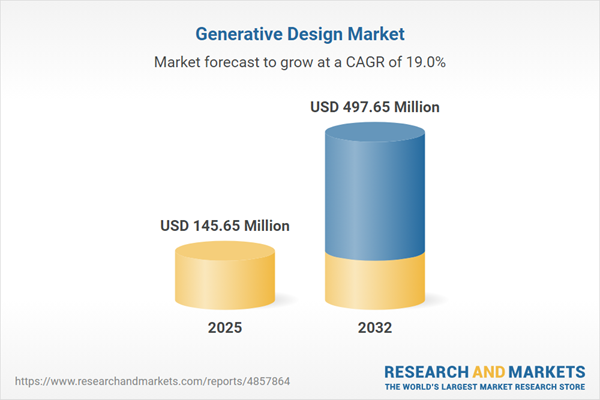Speak directly to the analyst to clarify any post sales queries you may have.
Generative design is emerging as a driving force for innovation, transforming engineering workflows and product development through advanced algorithms and artificial intelligence. Senior decision-makers now leverage this technology to address pressures of time-to-market, product complexity, and sustainability—all while powering a new era of cross-functional collaboration and data-driven creativity.
Market Snapshot: Generative Design Market Growth and Potential
The generative design market experienced substantial growth from USD 123.39 million in 2024 to USD 145.65 million in 2025, with expectations to reach USD 497.65 million by 2032 at a compound annual growth rate (CAGR) of 19.04%. This robust market expansion reflects increasing adoption of artificial intelligence and algorithmic optimization across multiple sectors, spurred by escalating needs for agile product development and sustainable engineering solutions. As demand accelerates for faster cycles, reduced development costs, and resilient supply chains, generative design is gaining ground among manufacturers and innovators globally.
Scope & Segmentation
This report delivers in-depth analysis across key market segments and technologies shaping the generative design landscape. Strategic segmentation covers:
- Components: Services (Consulting, Support & Maintenance, Training & Implementation) and Software solutions enabling automated, iterative workflows.
- Deployment Modes: Cloud-based platforms providing scalable resources and on-premises solutions addressing security and legacy integration requirements.
- Organization Size: Large Enterprises pursuing customized, enterprise-grade deployments; Small & Medium Enterprises opting for scalable, ready-to-use platforms.
- Industry Verticals: Aerospace & Defense, Automotive, Healthcare & Medical Devices, Consumer Goods & Electronics (spanning wearables, appliances, and electronics), Architecture & Construction (including building design and urban planning), and Industrial Equipment (covering heavy machinery and manufacturing equipment).
- Geographic Regions: Americas (United States, Canada, Mexico, Brazil, and others), Europe, Middle East & Africa (notably UK, Germany, France, UAE, Saudi Arabia), and Asia-Pacific (including China, India, Japan, Australia, South Korea, Singapore, among others).
- Leading Companies: Comprehensive trend analysis on 3D Systems, Adobe, ANSYS, Autodesk, Bentley Systems, Carbon, Dassault Systèmes, Desktop Metal, Google, Hexagon, Hyperganic, Microsoft, nTopology, NVIDIA, OpenAI, PTC, Siemens, and Synera.
Key Takeaways for Senior Leaders
- Generative design allows engineers and designers to explore thousands of permutations efficiently, accelerating innovation and reducing manual effort.
- This technology bridges concepts and production by offering data-driven recommendations on material selection, weight optimization, and structural integrity.
- Collaboration between design, engineering, and manufacturing is strengthened through integrated digital ecosystems, improving cross-functional productivity and fostering continuous improvement.
- Sustainability is prioritized as generative objectives incorporate material and carbon minimization, supporting regulatory compliance and circular economy initiatives.
- Industries with complex supply chains benefit through agile responses to market shifts, such as optimizing alternative material strategies and mitigating procurement risks.
- Competitive advantage is achieved through talent development, strategic partnerships, and tailored platform solutions that align with technical and market-specific demands.
Tariff Impact and Regulatory Dynamics
Emerging trade policies and substantial U.S. tariffs drive shifts in technology investments and supply chain strategies. Increased hardware and GPU procurement costs are prompting many enterprises to transition toward cloud-native generative platforms, ensuring scalable resources while reducing capital exposure. Teams are managing evolving compliance requirements through secure, encrypted collaboration portals and robust data storage. Firms embedding tariff-sensitive criteria directly into generative workflows can preemptively identify configurations that lower reliance on high-taxed components, ensuring operational resilience in volatile economic environments.
Methodology & Data Sources
Research findings are grounded in comprehensive interviews with industry leaders, design engineers, and CTOs. These primary insights are validated through expert panels and cross-checked with systematic reviews of technical literature, patent analyses, industry filings, and proprietary datasets. The report applies a multi-tiered data triangulation approach to ensure robust, actionable insights for every segment and region.
Why This Report Matters
- Drive informed strategic decisions by leveraging a comprehensive view of technological adoption, regulatory trends, and competitive positioning.
- Identify opportunities for innovation, risk mitigation, and ecosystem partnerships tailored to your operational context and growth objectives.
- Navigate complex procurement, sustainability, and talent development challenges with focused, practical recommendations directly aligned to board-level priorities.
Conclusion
Generative design is reshaping the boundaries of engineering, offering organizations an actionable path to greater agility and sustained innovation. Those who integrate data-driven creativity with adaptive strategy will capture lasting competitive advantage.
Additional Product Information:
- Purchase of this report includes 1 year online access with quarterly updates.
- This report can be updated on request. Please contact our Customer Experience team using the Ask a Question widget on our website.
Table of Contents
3. Executive Summary
4. Market Overview
7. Cumulative Impact of Artificial Intelligence 2025
Companies Mentioned
The companies profiled in this Generative Design market report include:- 3D Systems, Inc.
- Adobe Inc.
- ANSYS, Inc.
- Autodesk, Inc.
- Bentley Systems, Incorporated
- Carbon, Inc.
- Dassault Systèmes SE
- Desktop Metal Inc.
- Google LLC
- Hexagon AB
- Hyperganic Group GmbH
- Microsoft Corporation
- nTopology Inc.
- NVIDIA Corporation
- OpenAI, L.L.C.
- PTC Inc.
- Siemens AG
- Synera GmbH
Table Information
| Report Attribute | Details |
|---|---|
| No. of Pages | 196 |
| Published | November 2025 |
| Forecast Period | 2025 - 2032 |
| Estimated Market Value ( USD | $ 145.65 Million |
| Forecasted Market Value ( USD | $ 497.65 Million |
| Compound Annual Growth Rate | 19.0% |
| Regions Covered | Global |
| No. of Companies Mentioned | 19 |









